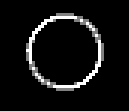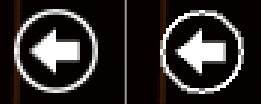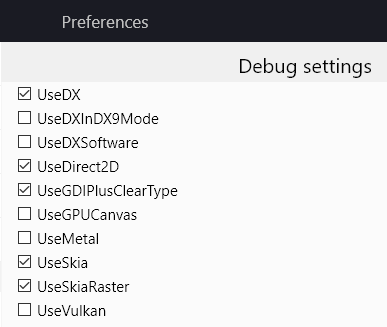

Hans♫
-
Content Count
140 -
Joined
-
Last visited
-
Days Won
5
Posts posted by Hans♫
-
-
It also depends on your need to access the hardware on the computer. If you need to access microphone, camera, harddrive, audio, USB devices, etc. you have much better control with an installed app. It is the case with both desktop and mobile devices. That's the reason we release our app on Windows, MacOS, Android and iOS.
-
 2
2
-
-
19 minutes ago, Rollo62 said:Is that always guaranteed?
Ha, ha, I am sure you know what I mean 😉 I'm no expert in the compilers memory management and optimization. I was trying to explain why it made no difference to add [ref].
I guess that if you create a "packed" record that is smaller than a pointer then it will be passed by value.
-
 1
1
-
-
50 minutes ago, Tommi Prami said:Tried that with record as parameter, did not see any speedup, const and const [ref] had same performance.
Thats because there is no difference. As the text says, with "const" only, the compiler decides the most efficient way. For a record the most efficient way is to pass its reference, so adding [ref] makes no difference.
-
3 minutes ago, Tommi Prami said:Is there some clear benefit of using [ref],m unless in need of doing something like in the FreeAndNil iomplementation.
I think the answer is in this text from the FreeAndNil article linked above:
... [ref], which forces the compiler to pass aconstparameter as a reference. Without it, the compiler can optimize passing ofconstparameter depending on the size of the parameter. -
On 12/5/2024 at 6:51 PM, Vanar said:I know for sure that it is possible.
In most applications from stores, when calling (showing) QR, the brightness of the iPhone screen increases ...Ok, thats great. So let me elaborate:
When you have found out what native functions are used in Objective-C to get the wanted result, then you can search the source code of Delphi for those functions. This will tell you exactly what function to call in Delphi to access the feature. Its of course nice to be able to get help here in DelphiPraxis, but its even better if you know how to find the solution on your own - and its much faster 🙂
-
 1
1
-
-
To increase the chances for a positive response, I would recommend to first check if its possible at all with XCode and Objective-C. If it's possible there then its usually also possible in Delphi, and then you can begin figuring out how its done and eventually ask about it here.
-
 1
1
-
-
Thank you so much 👍
We have successfully incorporated your new solution in our project (we use our own build script). It has also been tested on Play Store and that works too!
-
 1
1
-
-
13 hours ago, Dave Nottage said:you just need to switch from using play-core-1.10.0.jar to asset-delivery-2.2.2.jar
It might be a simple task for some, but at least not for me 🙂
First step of the switch is to create a Delphi interface to the new jar, and next step is to make the code work with that interface and jar.
With the current solution we used the interface to play-core-1.10.0.jar, that you created and supplied in your Kastri example project. I made a quick attempt to do the same myself for asset-delivery-2.2.2.jar, using Java2OP.exe and the instructions supplied by Embarcadero - but unsuccessful. I believe this is just the first problem, out of many, to complete this switch of jar's. Probably because I have no idea what I am doing... So I won't list the error messages here to start a problem solving session.
I think it is more beneficial for the Delphi community if its solved by a competent person and shared with the community - and I'll be pleased to pay for the work, even if its shared.
-
With the new API 34, it looks like the solution we made for install time assets, based on the Kastri example, no longer works.
When installing the resulting .aab on a device (Google Pixel8) running Android 14 it throws an security exception and the Install Time asset isn't loaded:
java.long.SecurityException: com.<applicationname>.android:
One of RECEIVER_EXPORTED or RECEIVER_NOT_EXPORTED should be specified when a receiver isn't being registered exclusively for system broadcasts
As far as I see, the problem is the play-core-1.10.0.jar (February 2021) is no longer accepted.
And we need to migrate to the new Play libraries (since April 2022)
https://developer.android.com/reference/com/google/android/play/core/release-notes
Specifically the Play Asset Delivery Library - Latest update 2.2.2 (May 2024)
https://developer.android.com/reference/com/google/android/play/core/release-notes-asset_deliveryAnyone having experienced the same?
-
-
On 5/12/2024 at 9:06 PM, vfbb said:Do you have a blank project simulating this?
Yes, I can reproduce this in a blank project. You did not see it because you used gray in gray. When using white on black, then you can see it:
<No Skia | Skia + Vulkan >


Enlarged:
<No Skia | Skia + Vulkan >


This is produced with an empty app with only this code:
GlobalUseSkia := true; GlobalUseSkiaRasterWhenAvailable := false; GlobalUseVulkan := true; ... procedure TForm1.PaintBox1Paint(Sender: TObject; Canvas: TCanvas); var lStroke: TStrokeBrush; lPath: TPathData; begin lStroke := TStrokeBrush.Create(TBrushKind.Solid, claWhite); lStroke.Thickness := 1.5; lPath := TPathData.Create; lPath.AddEllipse(RectF(-12, -12, 12, 12)); lPath.Translate(50,50); Canvas.Fill.Color := claBlack; Canvas.FillRect(RectF(0,0,100,100), 0, 0, [], 1); Canvas.DrawPath(lPath, 1, lStroke); lStroke.Free; lPath.Free; end;
-
Its a path. Our code looks like this (simplified):
fStroke := TStrokeBrush.Create(TBrushKind.Solid, claSilver); fStroke.Thickness := 1.5; fPath := TPathData.Create; fPath.AddEllipse(RectF(-12, -12, 12, 12)); ... Canvas.DrawPath(fPath, 1, fStroke);
-
On 5/8/2024 at 5:51 PM, vfbb said:@Hans♫ Please check your Form.Quality because the AntiAlias is direct related to the current form quality
Thank you. We had the Form.Quality set to SystemDefault, which seem to do the same as setting it to HighQuality. I tried to set it to HighQuality, but did not see any difference.
However, I just found out that with Skia+Vulkan, it actually draws with anti-aliasing, but in a very simple way.
Here is our back button. The version to the left is with no Skia. To the right it is with Skia + Vulkan:
<No skia | Skia+Vulkan>

I though the Skia+Vulkan version was not anti-aliased, but when enlarging, I can see that it is:

The quality of the anti-aliasing is simply lower with Skia+Vulkan (and the forms quality is set to high quality).
Is there a way to change that?
-
40 minutes ago, Dalija Prasnikar said:Do you have aliasing problem with Vulkan, too?
Yes, it looks the same both with and without Vulkan: no anti-aliasing.
-
3 hours ago, Dalija Prasnikar said:How it works when you UseVulkan?
Enabling Vulkan requires to uncheck SkiaRaster, according to the description.
We are seeing a performance improvement and it runs pretty smooth when unchecking the SkiaRaster. If there is an additional performance improvement by enabling Vulkan, it is not clearly visible, so I'll need to measure the frame rate to find.
However, unchecking SkiaRaster also disables anti-alias when drawing a path, so it is not currently an option.
Maybe that could be solved somehow by accessing the Skia Canvas?
-
-
46 minutes ago, Dalija Prasnikar said:@Hans♫ Do the Macs you tested it on have Apple Silicon? If they do then they also support tile based rendering.
Yes, we have both Intel macs and Apple Silicon macs at the office, but we currently build only for Intel and rely on the Rosetta 2 emulator. Both Intel and Silicon work "fine" when enabling Metal. However, we have not measured the framerate on animations or the painting speed, so here "fine" means that its high enough to not attract attention.
-
On 5/3/2024 at 4:56 PM, Rafal.B said:I want to confirm slow graphics rendering using GlobalUseSkia=True.
Thank you. Interesting where the bottleneck is?
BTW, we are not using the Skia Canvas (ISkCanvas), but as I understand the description, it is only needed to unlock more features, not to increase speed?
For now we can simply turn off Skia on Windows, and use it only on MacOS, Android and iOS. But as soon as we begin to implement SKIA specific functionality, it becomes more difficult to maintain, if we have to support non-Skia too.
-
5 minutes ago, Lars Fosdal said:Can you create a small app that demonstrates the problem and that you can share?
No, unfortunately a simple app does not have this problem.
And as a side-note, thinking about your question:
Asking "general" questions like I did is of course a tradeoff: When have I tried enough to ask?
I am sure I would be able to solve the problem on my own, but I also know that it could easily take a day, a week or even a month to solve. Sometimes just to find out that the solution was simple, but locating it was complex. Sometimes others have been through the same and discovered something that might not be obvious.
I admit that I asked my question early in the process, long before having tried all options. But that was with a hope that someone else have been through this and have some useful information 🙂
-
We have tried it on several PCs and laptops here at the office. Both new and old computers (and graphics cards), and both with 32 bit and 64 bit builds of our application. The result is the same everywhere. With Skia, the framerate is 2-4 fps, and without Skia the framerate is not visible, which I guess means 20+ fps.
PS. But if you want to know, I personally use a 12 years old AMD Radeon 6670, which is fast enough to run Delphi 🙂
-
Having Skia on MacOS is a great improvement because it allows us to enable Metal without losing rendering quality. However, on Windows we experience slow rendering with Skia.
We use Delphi 12.1 Patch 1, with our FMX based app. A full screen slide-in animation of a TFrame on top of the main form is smooth with GlobalUseSkia=false. When setting GlobalUseSkia=true, the framerate of the animation goes down to around 2-4 fps.
This is with GlobalUseSkiaRasterWhenAvailable=true. Setting GlobalUseSkiaRasterWhenAvailable=false, then the framerate doubles, but then vector graphics is no longer antialiased.
We have not changed any components or code in paint routines, but maybe we should?
Any idea what goes wrong?
-
55 minutes ago, Sherlock said:Windows VM on a Mac made it easy to develop for three platforms (Win, macOS, iOS)...
Good to hear. It's of course a tradeoff. Using a VM requires extra time and so do running multiple Delphi version directly in your main Windows installation. My conclusion so far is that the latter works better for me, despite often having problems when a new Delphi version is released.
-
 1
1
-
-
I solved it. There was still a node for "RAD Studio 12" in the Windows 10 uninstall registry. So I simply deleted that node from here:
HKEY_LOCAL_MACHINE\SOFTWARE\WOW6432Node\Microsoft\Windows\CurrentVersion\Uninstall\
PS. Using VM for multiplatform development is a PITA.
-
 2
2
-
-
54 minutes ago, Dalija Prasnikar said:... when you run the wizard at one point you will also have Three buttons under the settings tree: Update Migration, Version Migration, and Computer Migration. You should choose Version Migration when migrating form one version to another.
You are right, I didn't make any changes to the settings tree, as I expected it to be correct by default when having chosen "... to newer product version" on the first page.
Lesson learned!
Unfortunately I am still in a dead-lock that I cannot install Delphi 12 because it thinks its already installed. Have contacted support and waits for an answer, but I expect that it is just a single obfuscated registry value that needs to be removed to continue. Just don't know which.
![Delphi-PRAXiS [en]](https://en.delphipraxis.net/uploads/monthly_2018_12/logo.png.be76d93fcd709295cb24de51900e5888.png)

What is the best way to test FireMonkey app on iOS device?
in FMX
Posted
If you plan to buy a mac (mini), please note: the simulator only works on ARM processors. All new macs use ARM now, but if you buy an old one, be sure to avoid Intel. The first Mac Mini with M1 (arm) processor was released in 2020.